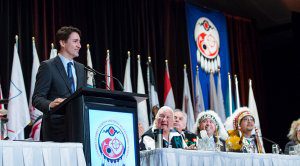 Instead, superficial promises by the government are sure to result in disappointment and dissatisfaction among Indigenous peoples who deserve far better from the government and the country, writes Ken Coates.
Instead, superficial promises by the government are sure to result in disappointment and dissatisfaction among Indigenous peoples who deserve far better from the government and the country, writes Ken Coates.
By Ken Coates, October 30, 2020
The federal government’s proposed legislation on the United Nations Declaration on the Rights of Indigenous Peoples is a broken promise waiting to happen. This legislation seems like a simple statement of justice, commitment to Indigenous rights and a determination to right past wrongs. Instead, it is almost certain to disappoint. In the process, it could well be the latest in a long string of broken promises to Indigenous peoples.
UNDRIP, which Canada accepted in 2010, is a comprehensive document that outlines the wide variety of acts of injustice perpetrated on Indigenous peoples around the world. The declaration covers language and culture loss, imposed education systems and attempts at assimilation, the occupation and use of Indigenous lands without community consent, and the imposition of government policies on marginalized Indigenous communities.
At the time, the document was described at the time as an “aspirational” document. Yet the Canadian government now wants to embed it in Canadian law, giving it substantial legal and political authority.
The government’s legislation is simple and short – it affirms UNDRIP “as a universal international human rights instrument with application in Canadian law” and then declares that the government “must take all measures necessary to ensure that the laws of Canada are consistent with” the UN document. As it goes on to say, this would include developing and implementing a “national action plan,” in “consultation and cooperation with Indigenous peoples,” to achieve the objectives of UNDRIP.
On the surface, these are respectful and appropriate steps. The references to consultation and cooperation – to the co-production of policy – is particularly valuable, for it suggests that the government will not barge ahead on its own. But UNDRIP is a very high-level document without specifics, including the time frame, costs, areas of priority application, and the relationship to Indigenous needs. The “national action plan” is a vital step, but it should precede or accompany, and not follow, the passage of the legislation.
Consider several elements in UNDRIP. Article 11 says, in part, “Indigenous peoples have the right to revitalize, use, develop and transmit to future generations their histories, languages, oral traditions, philosophies, writing systems and literatures, and to designate and retain their own names for communities, places and persons.” This is an invaluable commitment, one rendered necessary by systematic attempts to undermine and destroy Indigenous languages and cultures through a variety of formal (i.e., education) and informal means. Real action on this issue is long overdue.
But there are dozens of Indigenous cultures across Canada. Most of the Indigenous languages are at serious risk; several of them have only a small number of active speakers of the languages. Oral traditions and histories have been damaged by state intrusions and further undermined by popular culture. Indigenous place names have been replaced, often with those assigned by transient non-Indigenous travellers. Addressing this one set of issues will take hundreds of millions of dollars and several decades of concerted work, with no assurance of long-term success. Is the Government of Canada making a commitment here that it knows, in advance, that it cannot properly honour?
Article 22 says, in its second part, that “States shall take measures, in conjunction with indigenous peoples, to ensure that indigenous women and children enjoy the full protection and guarantees against all forms of violence and discrimination.” Canadians know that this is a matter of urgent concern for Indigenous women. A national commission looked into this matter and released a report that called for sweeping policy changes and initiatives. Frustration followed about the so-far tepid and limited response. It is hard to credit a government making a commitment to UNDRIP when inaction has characterized their response to date on this issue.
In other areas, Canadian practice is already consistent with UNDRIP principles. For example, Article 28, Part 1, says: “Indigenous peoples have the right to redress, by means that can include restitution or, when this is not possible, just, fair and equitable compensation, for the lands, territories and resources which they have traditionally owned or otherwise occupied or used, and which have been confiscated, taken, occupied, used or damaged without their free, prior and informed consent.” Supreme Court of Canada decisions, particularly on the “duty to consult and accommodate,” have provided substantial assurance – better than those enjoyed by most Indigenous peoples internationally – of the right to influence development projects. In some areas, Canadian approaches are already generally consistent with UNDRIP principles.
UNDRIP has many valuable and important elements, not the least of which is the realization that the experience of Indigenous peoples in Canada closely mirrors situations in other countries. The document outlines the long list of challenges and historical injustices facing First Nations, Métis, and Inuit peoples in Canada.
But the thinly drafted commitments in the federal government’s proposed legislation does not provide a path forward to real and sustained reconciliation. Instead, superficial promises by the government, tied to a document that includes 46 articles requiring dozens of urgent action items, are sure to result in disappointment and dissatisfaction among Indigenous peoples who deserve far better from the government and the country.
Ken Coates is a Munk Senior Fellow at the Macdonald-Laurier Institute.




